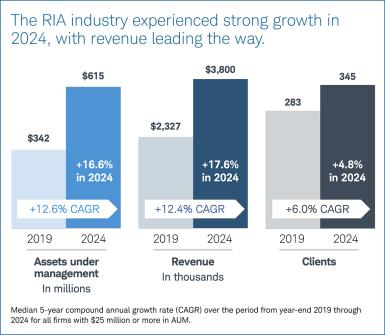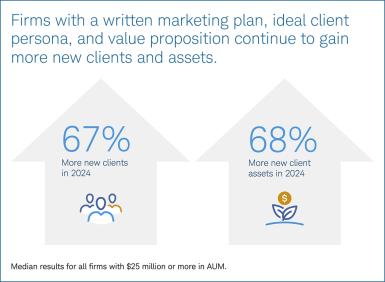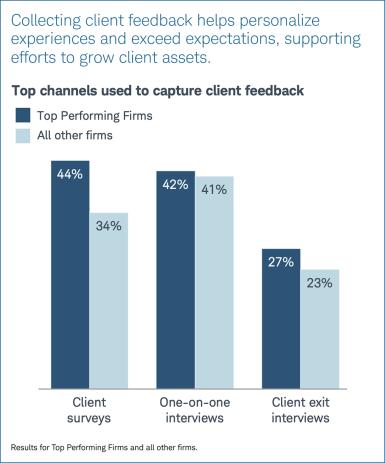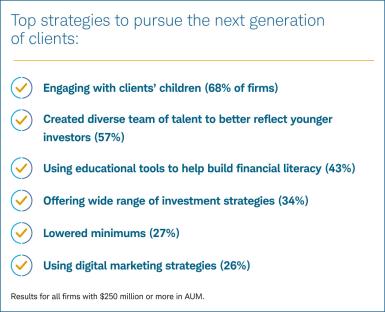2025 RIA Benchmarking Study: Growth drivers and performance
What Schwab's recent study tells us about how firms drive growth
Key Points
-
- In Schwab's 2025 RIA Benchmarking Study, Top Performing Firms1 show which strategies are helping registered investment advisors (RIAs) grow more quickly.
-
- Organic growth remains a top priority for advisors and played a pivotal role in the overall growth of RIA firms in the study.
-
- Personalizing and expanding services are high priorities for RIAs looking to retain younger clients and win over a generation that's poised to receive a massive wealth transfer.
In 2024, RIAs that custody with Schwab again reported strong organic growth, which contributed to another year of growth in overall assets, revenue, and clients.2 In fact, over the last five years, the compound annual growth rate of assets and revenue is above 12%.3
These are the latest findings from Schwab's 19th annual RIA Benchmarking Study, which gathered insights from 1,288 participating RIA firms. Study participants shared their firm data and business priorities and received access to personalized results that show where they stand among their peers and what they can do to keep making progress toward their goals.
This year's study found that client trust, efficiency, scale, and new strategies are helping independent advisors win over new clients, serve them better, and increase assets per advisor. Top Performing Firms, in particular, offer a roadmap for RIAs looking to tap into new opportunities and serve clients more efficiently.
Here are a few strategies—backed by RIA Benchmarking Study data—that are helping growth-focused firms achieve long-term results.
Plan for organic growth
Top Performing Firms saw twice as much revenue growth and attracted 85% more new clients at the median than all other firms. One big reason may be planning for growth. Top Performing Firms typically have a written strategic plan, an ideal client persona, a client value proposition, an integrated marketing plan, and written referral plans.
Referrals offer a significant opportunity for organic growth as advisors build on the success of current relationships. But referrals aren't likely to happen by accident. Firms that succeed at generating referrals often develop a comprehensive strategy that includes specific goals, outreach tactics, and a clear delineation of responsibilities.
Personalize experiences
Across the study, 95% of all firms are focused on enhancing the client experience.
As technology allows advisors to take customization deeper, there's an opportunity for advisors to get creative. Artificial intelligence (AI) tools have the potential to help firms find and organize information quickly, allowing them to analyze client data to uncover preferences, goals, and tendencies. With this information, advisors can gain a deeper understanding of what their clients want and provide more on-target solutions.
Most Top Performing Firms focus on personalization by first developing an ideal client persona. Once they understand the type of client they work with best, they're able to hone their services and communications to their ideal client's needs. In fact, the more you know about your clients, the more it makes sense to develop a formal strategy to segment specific client groups. For example, clients with fewer assets are likely to need fewer services, but as you move up the asset scale, your investment in time and resources may need to increase. The effectiveness of segmenting a firm's offer to various client groups may be why 55% of Top Performing Firms have a segmentation strategy.
Collecting client feedback can help firms increase assets from existing clients—especially during major wealth events, such as 401(k) rollovers, inheritances, and business sales. By uncovering what matters most to clients, this feedback allows firms to personalize the client experience, exceed client expectations, and proactively prepare for wealth events. Here, too, an intentional plan for collecting feedback makes a difference.
Focus AI on efficiency
More advisors are seeing the power of AI to streamline operations, increase productivity, and reduce costs. This year's study found that firms are using AI for4:
- Administrative support, such as note taking, creating meetings, or drafting emails (43% of firms)
- Generating marketing content (38%)
- Developing client correspondence (31%)
- Conducting research (22%)
- Developing client education (13%)
Firms that carefully consider the privacy and ethical implications of AI, have clear policies and procedures to govern the use of AI, and understand how to use the technology to elevate the client experience may find that AI can help them increase the number of clients and amount of assets under management (AUM) per professional.
Outsource for scale
Across the study, 85% of all firms outsource some technology tasks and 83% outsource some compliance. Marketing, human resources, and bookkeeping are also common targets for outsourcing.
For a fast-growing firm, hiring and building systems within the firm can slow down growth because they pull time and resources away from serving clients and winning new ones. Many firms are finding that by outsourcing, they're able to scale at the pace of their growing business.
Be open to M&A
Over the past five years, 41% of firms have engaged in inorganic activity.5 A merger or acquisition isn't for everyone, but inorganic growth remains popular because it can help firms solve many kinds of challenges.
Firms report pursuing inorganic growth to increase AUM, revenue, and client growth (92%), acquire talent (67%), and create scale (59%). M&A may also be the beginning of a succession strategy (37%) for some firms that don't yet have young leaders ready to take over and some firms report looking to M&A to solve operational issues (45%).6
Develop intergenerational strategies
By 2048, $105.3 trillion is expected to be passed on to heirs.7 With such a massive wealth transfer on the horizon, many firms are offering intergenerational planning strategies and services, including family education (72% of firms), estate planning (75%), and charitable planning (86%).8
Uncover your own insights
If you want detailed and personalized benchmarking results, and your firm custodies with Schwab, consider participating in the next RIA Benchmarking Study. All study participants receive access to an interactive dashboard that lets them view their firm's results across multiple comparison groups, allowing advisors to see strengths and areas for improvement. Check out more results from this year's study.
What you can do next
- If you're interested in taking part in the next RIA Benchmarking Study, talk to your Account or Relationship Manager, or visit our benchmarking page to learn more.
- Consider a custodian that is invested in your success. Contact us to learn more about the potential benefits of a Schwab custodial relationship.
1. Top Performing Firms are those that rank in the top 20% of the Firm Performance Index. The index evaluates all firms in the study according to 15 metrics to arrive at a holistic assessment of each firm's performance across key business areas.
2. Organic growth is the change in a firm's assets from new, existing, and lost clients before investment performance is taken into account, and it excludes the growth from acquisitions, divestitures, and advisors joining or leaving.
3. Median 5-year compound annual growth rate (CAGR) over the period from year-end 2019 through 2024 for all firms with $25 million or more in AUM.
4. Results for all firms with $250 million or more in AUM.
5. Results for all firms with $250 million or more in AUM. Inorganic activity represents mergers and acquisitions, divestitures, and advisors joining or leaving, from 2020 through 2024.
6. Results for all firms with $250 million or more in AUM.
7. The Cerulli Report, U.S. High-Net-Worth and Ultra-High-Net-Worth Markets 2024.
8. Results for all firms with $250 million or more in AUM.
About the 2025 RIA Benchmarking Study from Charles Schwab
Schwab designed the RIA Benchmarking Study to capture insights in the RIA industry based on survey responses from individual firms. The 2025 study provides information on topics such as asset and revenue growth, sources of new clients, products and pricing, staffing, compensation, marketing, technology, and financial performance. Fielded from January to March 2025, the study contains self-reported data from 1,288 firms that custody their assets with Schwab and represents over $2.4 trillion in assets under management, making this the leading study in the RIA industry. Schwab did not independently verify or validate the self-reported information. Participant firms represent various sizes and business models. The study is part of Schwab Business Consulting and Education, a practice management offering for RIAs. Grounded in the best practices of leading independent advisory firms, Business Consulting and Education provides insight, guidance, tools, and resources to help RIAs strategically manage and grow their firms.
Past performance is not an indicator of future results.
The Firm Performance Index evaluates firms in the study according to 15 metrics that align with the Guiding Principles for Advisory Firm Success, to arrive at a holistic assessment of each firm's performance across key business areas. It provides comprehensive comparisons for all firms participating in the study, not just within a peer group. The metrics in the Firm Performance Index measure growth in clients, assets and revenue; client attrition; staff attrition; operating margin; time spent on client service; time spent on operations; standardized workflows; written strategic plan and succession plan; and ideal client persona and client value proposition. The Firm Performance Index is calculated among all firms in the study without regard to assets under management or firm type. Firms that rank in the top 20% of the index are included in the Top Performing Firms.



